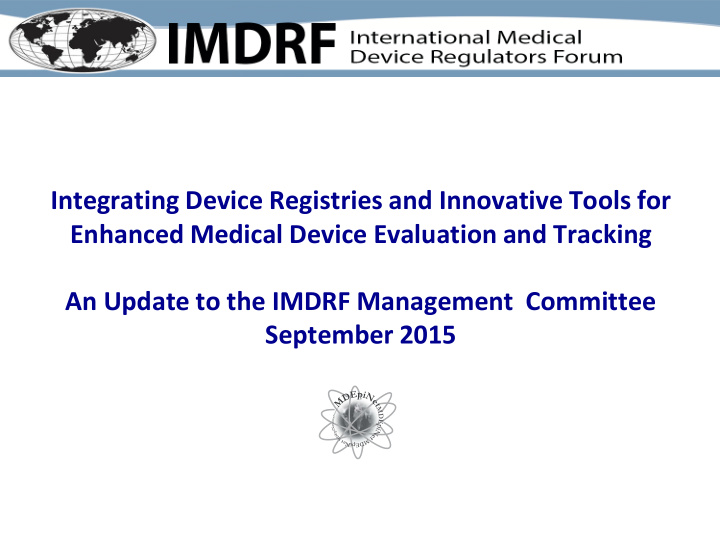



Integrating Device Registries and Innovative Tools for Enhanced Medical Device Evaluation and Tracking An Update to the IMDRF Management Committee September 2015
Scope • Evaluate, compare & contrast current approaches to international data models in different device areas: – Orthopedics – Cardiac – Vascular • Generate essential principles document(s) for international collaboration & data sharing related to: – Data access, security, governance, informatics and related issues – Analytic methodologies for safety signal detection, device effectiveness & reliability • Complete proposal in two stages: – Essential principles of data linkage for regulatory convergence (Stage 1) – Essential principles of analytic methodologies for device evaluation (Stage 2) 2
Vision • Strong registries and collaborative distributed data consortia are key pillars of this international collaboration. • The international collaboration will harness the global strength of international experience with devices, and leverage individual country strengths in cardiac, vascular and orthopedic areas. • While not all countries will contribute data to every device evaluation, all countries will benefit from the global collaborative.. 3
Vision (cont) • Worldwide, regulators will initiate early engagement with their respective registries and other data sources to (a) commence multi-stakeholder communication of their needs and (b) establish a value proposition for implementation/strengthening of device registries within existing registry systems. • The international collaboration will establish a forum and a set of priority device safety and effectiveness questions in collaboration with registry leaders and other stakeholders. 4
Vision (cont) . • The priority device questions in cardiac, vascular, orthopedic, and other clinical areas will be sufficiently broad to facilitate registry creation/collaboration but also sufficiently specific informed by international dialogue and intelligence sharing. • Priority device questions will be dynamic, changing over time as they are answered and as new questions emerge. • Continuous (e.g. semi- annual) analyses of safety issues found by registry consortia (e.g. ICOR, ICVR, ICCR) will be undertaken in order to keep stakeholders informed about consistent or changing risk posed by devices 5
Definition: Medical Device Registry An organized system with a primary aim to improve the quality of patient care that continuously collects relevant data, evaluates meaningful outcomes and comprehensively covers the population defined by exposure to particular device(s) at a reasonably generalizable scale (e.g. international, national, regional, and health system ). 6
Agreed on Additional Key Registry Qualifiers DEVICE : Contains sufficient information to uniquely identify the device (e.g. catalog number and manufacturer) or relevant attributes and, in the future, includes the unique device identifier. QUALITY SYSTEM: Is part of quality assurance system or evolving into one as device technologies are diffused into practice and need continuing evaluation (including outlier identification). BENEFICIAL CHANGE : Has established mechanisms to bring about beneficial change in health care delivery through stakeholder participation, ownership and integration into the relevant health care systems. EFFICIENCY: Is embedded in the health care delivery system so that data collection occurs as part of care delivery (i.e., not overly burdensome, not highly complicated, not overly costly, etc.) and integrated with work flow of clinical teams ACTIONABLE DATA: Provides actionable information in a relevant and timely manner to decision makers. TRANPARENCY: Governance structure, data access, and analytical processes of the registry are transparent LINKABILITY: Information in the registry can be linked with other data sources for enhancement including adequate follow up achievement. TOTAL DEVICE LIFE-CYCLE : Can serve as infrastructure for seamless integration of evidence 7 throughout the device life cycle.
Evaluated Existing Registry Efforts • Applied the agreed upon qualifiers to individual registries • Selected registry examples from participating countries • Examined early international collaborations • Examined evolving international consortia • Orthopedic • Cardiac • Vascular 8
Data Quality and Robustness • Best Practices: – Beyond Compliance Program (orthopedic -UK) – TVT Registry (cardiac- US) 9
Ensuring Analysis Validity when Linking • Registries and: – Unique Device Identification – Unique Patient Identification – Patient Reported Outcomes – Governance to encourage linking 10
Other updates • Since the Face to face mtg in Tokyo – Developed and sent to IMDRF regulators the questionnaire on how they use the registries – Created draft report – In the process of obtaining the input from the Mirror Groups (MDEpiNet and EU regulators) – Submitted the report to the IMDRF MC – Based on input – plan the next face to face mtg. 11
Recommend
More recommend